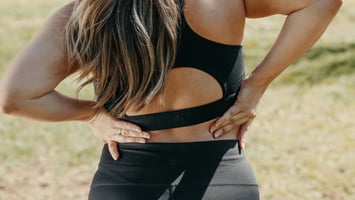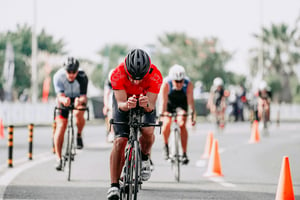When most runners think about injuries, they usually picture knee pain or Achilles tendinitis. But...
Get Ready to Squat Like a Pro: The Ultimate Warm-Up Guide

Before you hit the gym and dive into your squat routine, let’s take a moment to talk about something just as important as the squats themselves: the warm-up! Think of warming up like prepping the stage for a blockbuster performance—without it, you’re missing out on the full potential of your workout.
Squatting is an important exercise that provides several benefits to the body. It is a compound movement that targets several joints and muscle groups in the body including the quadriceps, hamstrings, glutes, and calves. Performing squats also requires significant engagement of the core muscles, including the abdominal and lower back muscles, to stabilize the body. This makes them highly effective for building strength, size, and endurance in all of these key areas! Before dominating your squats, it is important to ensure you have sufficient mobility and activation of all of the involved joints and muscles!
In this blog, we’ll guide you through the essential warm-up exercises that will set your muscles and joints up for success. We’re talking about more than just a quick stretch; we’re diving into dynamic movements and drills designed to activate, energize, and prepare your body for those deep, powerful squats. Whether you’re a seasoned lifter or just starting out, these warm-ups will help you move better, lift stronger, and avoid injury, all while making your squats smoother and more effective.
Mobility:
First, let's get into some mobility. Here’s why mobility plays a key role in squatting:
-
Proper Form: Good mobility ensures your joints—particularly the ankles, knees, and hips—can move through their full range of motion, helping you maintain proper alignment throughout the squat. Proper alignment reduces the risk of injury by preventing excessive strain on certain joints or ligaments and enhances the effectiveness of the exercise.
-
Depth and Range of Motion: Adequate mobility allows you to achieve a full squat, going as low as possible while maintaining good form. Limited mobility can restrict your range of motion, leading to a shallow squat that doesn't fully engage your muscles.
-
Joint Health and Injury Prevention: Proper mobility helps distribute forces evenly across your joints, reducing the risk of overuse injuries and strain. If certain joints lack mobility, other parts of the body need to move excessively which can lead to injury. For example, limited ankle mobility can cause compensatory movements that put extra stress on your knees and lower back.
-
Muscle Activation: Enhanced mobility ensures that the right muscles are activated throughout the squat. Limited mobility can cause you to rely on compensatory muscles or incorrect movement patterns, reducing the effectiveness of the exercise.
-
Balance and Stability: Good mobility contributes to better control, balance and stability during the squat. When your joints and muscles move through their full range of motion, you can maintain better control over your movement, reducing the likelihood of wobbling or losing your balance.
-
Movement Efficiency: Improved mobility allows for smoother and more efficient movement patterns. This efficiency can enhance your overall performance and help you lift heavier weights with better form.
-
Functional Movement: Squatting is a functional movement that mimics many everyday activities, such as sitting down and standing up. Good mobility ensures that you can perform these movements easily and safely in daily life.
Basically, mobility is essential for optimizing your squat performance. It allows for better form, greater depth, improved muscle activation, and reduced risk of injury. Regularly working on your mobility can lead to more effective squatting and overall better movement quality. Here are some mobility exercises that we feel are most important to incorporate in your pre-squat warm up routine!
Hip Mobility: Prying Deep Squat and Posterior Hip Capsule Stretch
Prying Deep Squat
To perform this, stand with your feet at least shoulder width apart (or further) and holding a 20# weight to your chest, sink into a deep squat. Now, place your elbows on the insides of your thighs, and drive your knees apart. Rock side to side to feel a great stretch deep in the hips. Hold this for 30s and perform 3 repetitions.
Posterior Hip Capsule Stretch
Sometimes, if the posterior capsule of the hip is tight, it will be difficult to reach the bottom of the squat. It is a great idea to stretch this to ensure it does not limit squat depth or cause any other compensations. To perform this stretch, begin on hands and knees in a quadruped position. Straighten the left (L) leg and rest the ball of the foot on the ground. Next, swing the right (R) foot to the left and bring the L knee up to the R ankle junction. If needed, bring the R foot up so that it is level with the R knee. Shift your weight forward so the hips are directly above the knees. Next, shift your body weight to the R and sit diagonally back.
Ankle Mobility: Dorsiflexion Mobilization
Ankle mobility is often overlooked while warming up for squats, but ankle motion, especially dorsiflexion range of motion (think: knees over toes), is extremely important to achieve proper form. When the knees are able to track forward over the toes, it allows us to keep our chest up during a squat.
The kneeling ankle dorsiflexion mobilization is a great exercise to increase dorsiflexion mobility.
To set this movement up, get into a tall kneeling position with your front foot a fists length away from the wall or squat rack. Next, gently drive your knee over your toes trying to get your knee to touch the wall or squat rack in front of you. Hold this position for 10s and perform this motion 5-10 times.
Muscular Activation:
Now that we have mastered mobility, lets focus on muscular activation and why it is also crucial for squats:
-
Optimal Force Production: Proper activation of muscles like the quadriceps, hamstrings, glutes, and core ensures that these muscles generate the necessary force to lift and control the weight during the squat. Without adequate activation, you can't generate enough power, which can limit your performance and progress.
-
Stability and Balance: Muscles such as the core, lower back, and hip stabilizers help maintain balance and stability throughout the squat. Good muscular activation helps prevent wobbling or falling over, ensuring that you can perform the exercise safely and effectively.
-
Joint Protection: Activated muscles help absorb and distribute forces evenly across your joints, reducing the risk of injury. Proper activation ensures that your muscles are working together to support your joints, particularly your knees and hips, during the squat.
-
Proper Form: Effective muscular activation helps you maintain proper squat form, which is key for maximizing the exercise's benefits and minimizing the risk of injury. For instance, engaging the glutes and core helps keep your torso upright and prevents excessive forward lean.
-
Muscle Engagement and Growth: Targeting and activating specific muscles during squats ensures that you're working them effectively, which can lead to better muscle growth and strength gains over time. Proper activation ensures that the intended muscles are being stressed, which is essential for muscle development.
-
Efficiency and Performance: Effective muscular activation improves your overall efficiency and performance in squats. You’ll be able to lift heavier weights, perform more repetitions, and achieve better overall results when your muscles are firing properly.
Here are some examples of muscular activation exercises you can perform to prime your body to perform some killer squats!
Core activation: RKC Plank
Core activation facilitates core engagement while moving through a squat. This increases the stability and alignment of your spine and torso while you squat. By stabilizing the torso, the core helps maximize the efficiency of force production in the legs, leading to better performance and the ability to lift heavier weights. This also helps to prevent injury!
A great core activation exercise is simply a plank, but here at Paradigm, we prefer a progressed version of a plank called an RKC plank. Perform this plank with your elbows and feet placed shoulder width apart. Rise up into a plank position. Now, drive your elbows into the ground and engage the lats so that you feel like you are attempting to drive your elbows down towards your feet. Squeeze the core, tuck the pelvis and squeeze the glutes. Basically, you should feel like you are squeezing every muscle in your body! If you are performing this correctly, it should feel very difficult. Hold this position for at least 10s and repeat 5x or as many times as you feel you need.
Glute activation: Lateral Band Walks
To perform these, place a resistance band around your ankles or mid shin. Sink into a mini squat, tuck your pelvis and engage your core. Facing sideways, take a small lateral step with one leg, keeping your knees, toes and hips facing forward. Then bring your trail leg in to meet the other leg in a controlled motion.
By incorporating these dynamic warm-up exercises into your pre-squat ritual, you’re not only preparing your muscles but also setting yourself up for peak performance and injury prevention. Remember, a great workout starts with a great warm-up, and with these exercises in your toolkit, you’re primed to hit those squats with power and precision. So, go ahead—take this newfound energy and enthusiasm into your next workout, and watch as your squat game reaches new depths. Keep moving, stay strong, and, most importantly, have fun with every rep. Your best squats are just a warm-up away!
Ready, set, squat!


.jpg?height=200&name=pexels-ajaybhargavguduru-863988%20(1).jpg)

